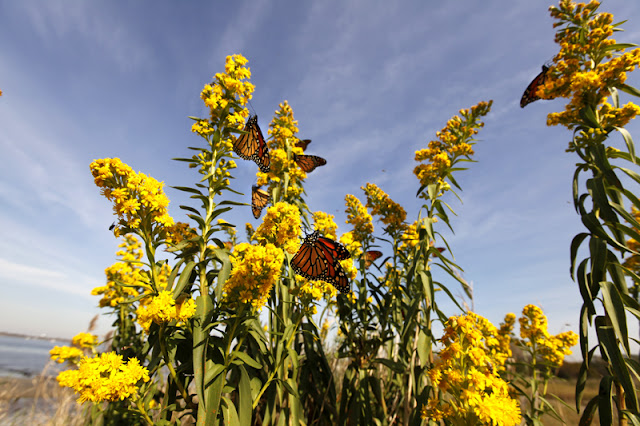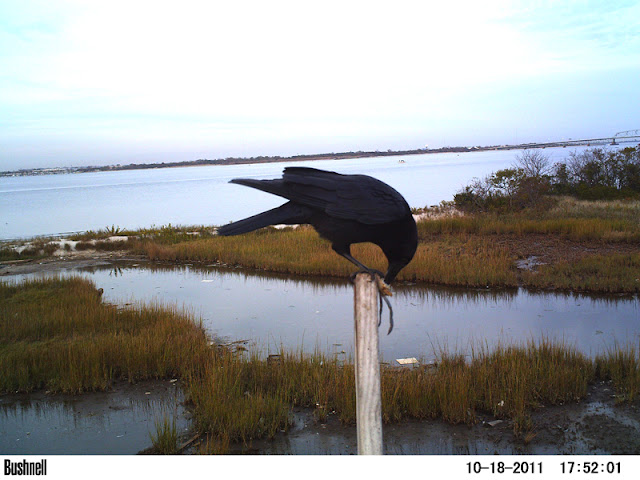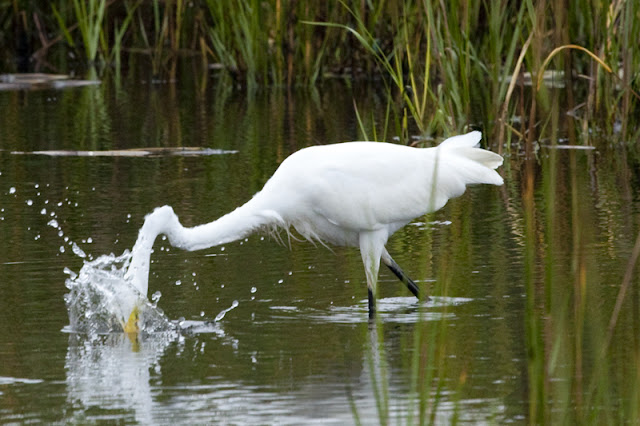My apologies for the radio silence. Much has transpired since I posted last, and this, I regret, will be my penultimate post. I'll explain later, but first, let me dutifully recount the events of the last two cleanup days. The first was October 10th, when Rocky Point was besieged by more monarchs then Willy and Kate's wedding.
Wherever there was goldenrod there were butterflies. So consumed were they with their migratory feast that they forgave the big black lens violating their personal space.
Tony, Broc, Moshe and I spent that afternoon inching massive logs out of the water with the help of a come-along. It was back-breaking stuff, but we managed to get them high enough to dry out and prevent them from being reclaimed by the next big tide. We were all too occupied to take pictures but here's how it went down:
The camera trap disappointed again. Pointing down at the platform, it yielded only a few shots of phoebes, sparrows, and other small fry. Don't get me wrong, I think these little guys are swell. But I wanted something new.
So I tilted it up to aim at the opposite brace. A week later, I returned to check the results.
And darned if I didn't camera-trap my first fish. A bunker (aka menhaden), slowly being eaten by the osprey perched atop the mount.
A total of four bird species were subsequently captured. Clockwise from upper left: fish crow, flicker, mockingbird, kingfisher. The framing made for an interesting size comparison.
How do I know it's a fish crow? I don't, really, but here it is eating a crab.
October 19 was not an easy cleanup day. The rain fell on an epic scale. An oppressive haze of swirling mist punctuated by jolts of sideways rain clouded the marsh sufficiently to obscure the bay and the city beyond. But I couldn't leave, because it was to be my last day in the marsh, maybe for a long time. A confluence of events compelled me to move back to my hometown of Portland, Oregon, and I couldn't take the marsh with me.
The irony was piercing. No lazy Indian summer farewell, none of the familiar birds flitting about. Marsh dwellers know better than to linger during a storm. Just me and the brutal downpour. It was as if the marsh was trying to shoo me away like Timmy did Lassie.
Then, as I waded around looking for debris to ceremoniously rake up, this appeared. At first glance I took it for a shred of plastic.
It's called salicornia, or Virginia glass wort. It was there all along, but in Autumn it turned this neon, impossible fuchsia. I didn't know such a thing could exist outside of the sci-fi realm.
After staring at it a while I hauled my last load of wood to the culvert, where I launched this operation a year ago. And there I considered all we'd accomplished.
We had a good run. And with that, I bow to the marsh, the NPS, Breezy Point, Jamaica Bay, New York City, and all of the wild creatures that dwell therein, or just stop by on their way somewhere else. I hope they find refuge here.
What will happen to Rocky Point marsh? Check back soon for the final installment.





















































